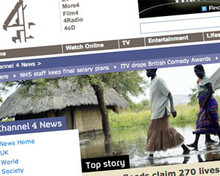
This might be the fastest interview I have ever conducted. I talk very quickly and Jon Bernstein isn't doing badly either - the coffee must really have kicked in.
Fortunately, the multimedia editor of Channel 4 News is a little more coherent than I. Equally fortunate; he's doing most of the talking and we're straight to the heart of the matter.
The subject is how do broadcasters square the circle of putting their video news on the web, while making it easy to access and appealing to an audience used to the quick hit of YouTube clips.
In July, the head of BBC News Interactive revealed the results of an internal experiment to embed flash video (a la YouTube) into the head of a story, rather than linking to a standalone player.
The experiment revealed that 40 per cent of people clicking through to the story page were watching the embedded video.
In its normal format, when users could only watch in a standalone player, only about two per cent were taking that option.
"That two percent figure tallies with what we are finding," Bernstein said.
"There are exceptions, but the norm is that of the people coming to read the text story only a small percentage will then go and watch the video."
He adds 'plans are afoot' at Channel 4 News to use more embedded video. The standalone player idea, he believes, is technology with a limited lifespan.
"YouTube has educated the market that video on the web is embedded, you click the play icon and away you go… a few years ago the convention was to have a video player and a jukebox of things to watch and that was perfectly valid.
"But sometimes you have to say the market has moved on, someone else is there saying how it works."
Beside ease of use, the other great advantage of embedded flash video is that by providing a simple line of code videos can easily be exported to other websites and blogs, giving news producers the option of letting their news be distributed virally away from their website.
Not a point that sits easily with all news video producers, but not a problem for Bernstein - 'I'm 100 per cent behind it', so long as the rights can be agreed first.
"Does it cannibalise our market elsewhere? All the evidence suggests it doesn't. The more you extend the reach the more you get brand recognition, the more people come back to you website.
"But even if they didn't come back to your website, in a sense that doesn't matter. Channel 4 has a public service remit and Channel 4 News and all the current affairs programmes deliver that.
"Part of our objective is to extend our reach, and what's the best way to do that? Allowing people to embed our video on their websites.
"It's arrogant to expect everyone to type in Channel 4 News, come to our website to consume the stuff, it's very late 1990s dotcom strategising, life doesn't work like that."
Part of the vision, he said, was to add value to, and complement, the TV broadcast by creating communities around specialist interests and then to use correspondents to add the depth and detail to issues they can't get across in the TV broadcast.
"We really need to rethink what people want in terms of footage on the web. A lot of web behaviour is people in browse mode and they are going about to have their questions and answered.
"With a breaking story it's slightly different, you are telling them something they didn't know. But with other stories when they have background knowledge they are either looking for an answer to a question… or looking for that little Crown Jewel piece of information or entertainment related to the story."
It boils down to two extremes, water cooler footage (that memorable video curio) or the Crown Jewels, the essence of a news story.
"We did a piece off the back of Dispatches' Undercover Mosque and we had an interview with the commissioning editor of Dispatches and one of the clerics at the mosque in question, it was just a fantastic three-way interview.
"It was really compelling, but rather than the whole package of the controversy around the mosque programme, what people wanted on the web was that interview, and we knew that was what people wanted to watch because low and behold, it turned up on YouTube.
"That was the real gem of what we were doing and I think that when you are in the broadcast mentality the thinking is 'that package worked for broadcast, it'll work for the web'.
"Sometimes that's absolutely true, but invariably it's just that little bit, that 20 or 90 seconds that people want to watch again and again and again."
And with that, my Crown Jewel moment is over.
Free daily newsletter
If you like our news and feature articles, you can sign up to receive our free daily (Mon-Fri) email newsletter (mobile friendly).
Related articles
- How Reuters, Newsquest and BBC experiment with generative AI
- Standing out in a crowded market: what makes a top news podcast?
- How can UK commercial local news media respond to BBC expansion?
- European broadcasters must address on-screen diversity
- Digital News Report 2023: Five trends to watch in the UK









